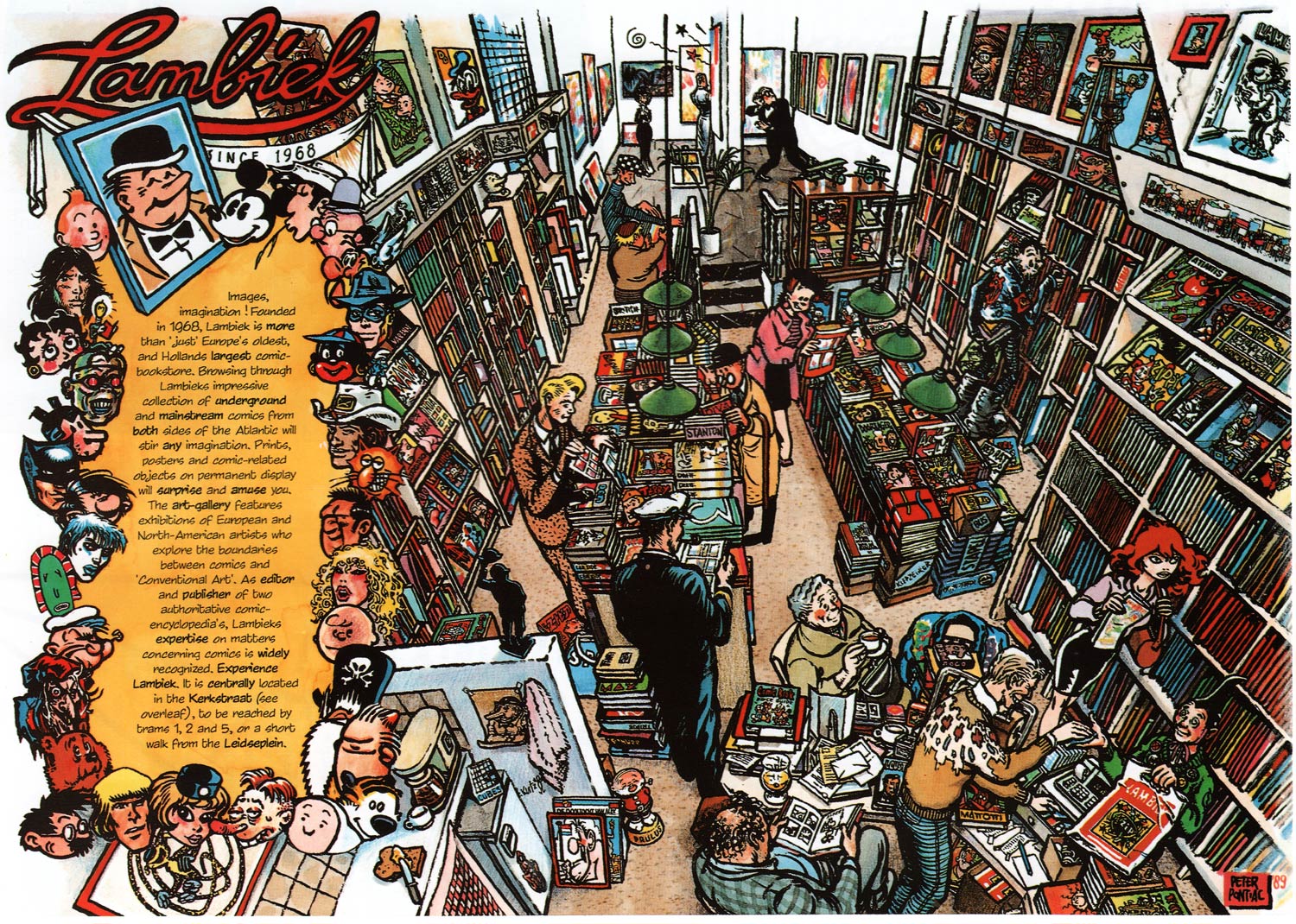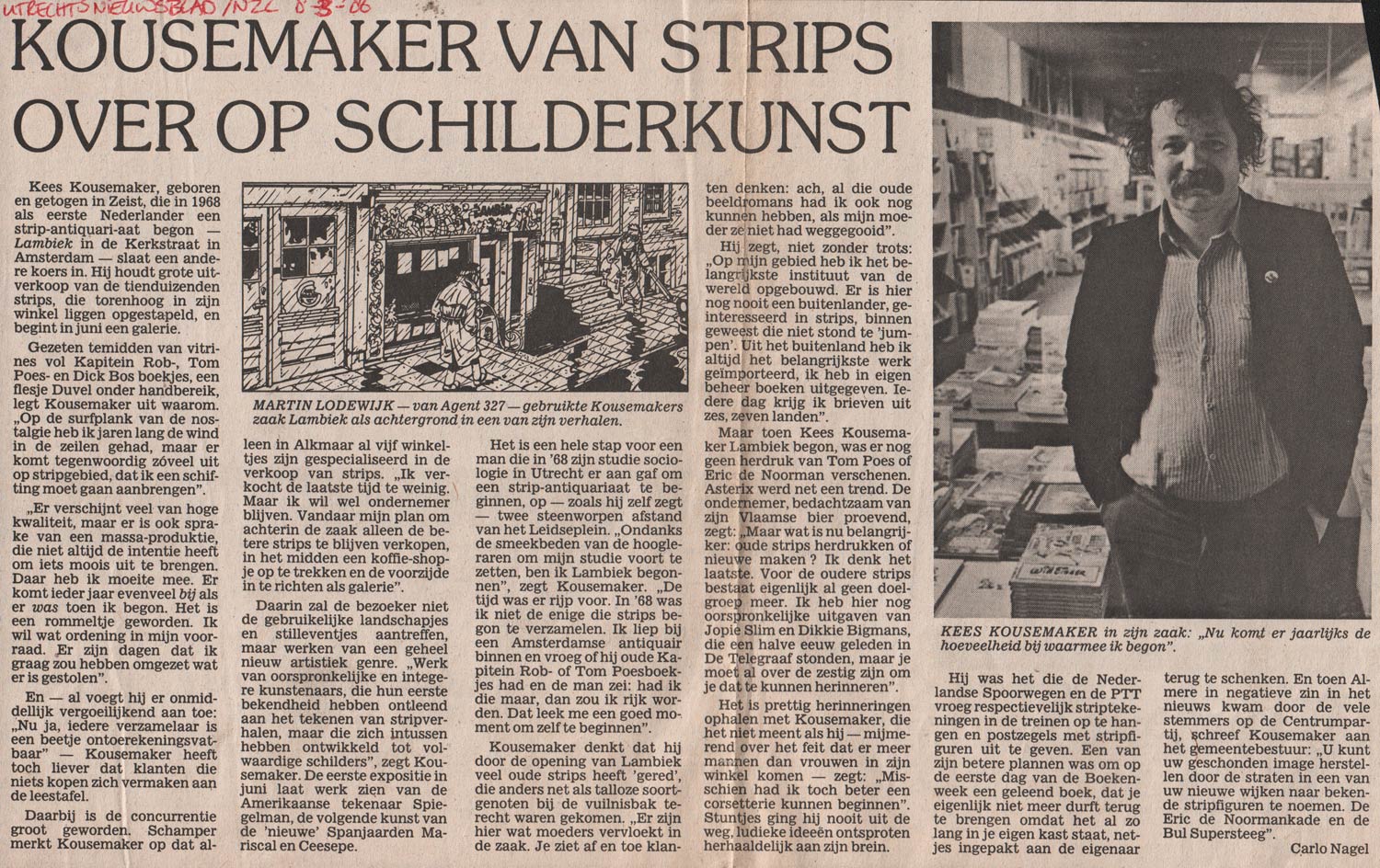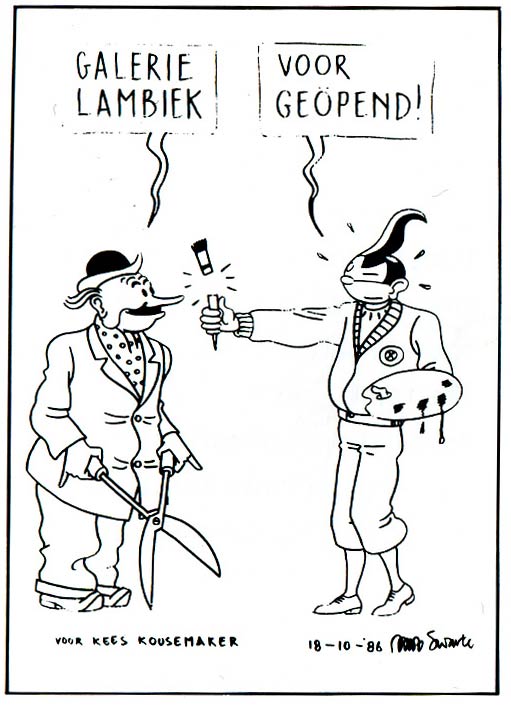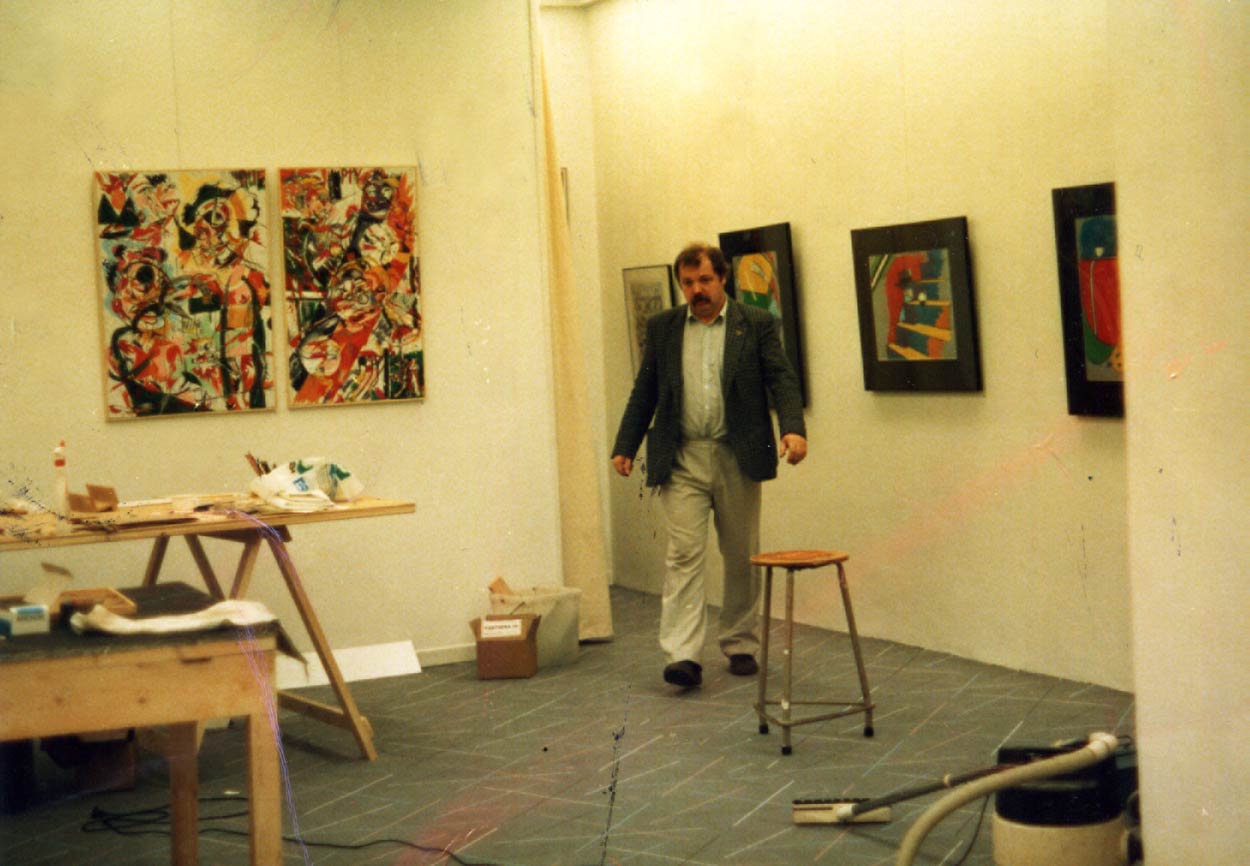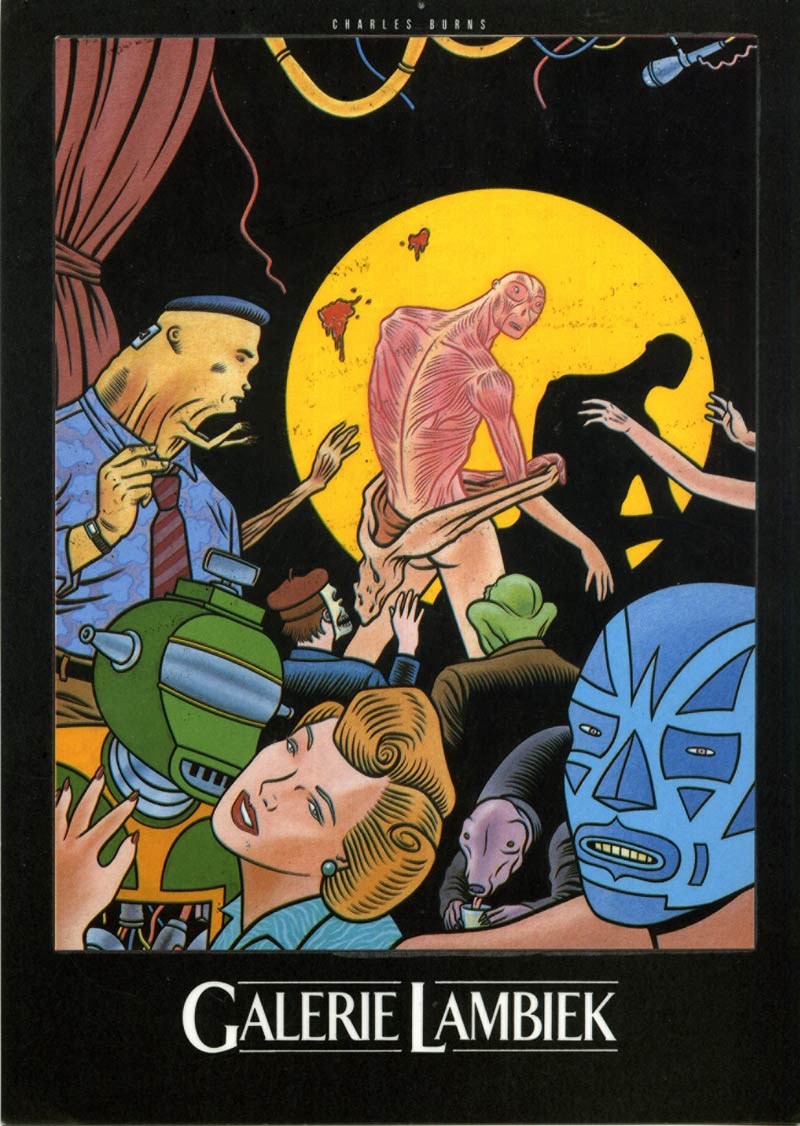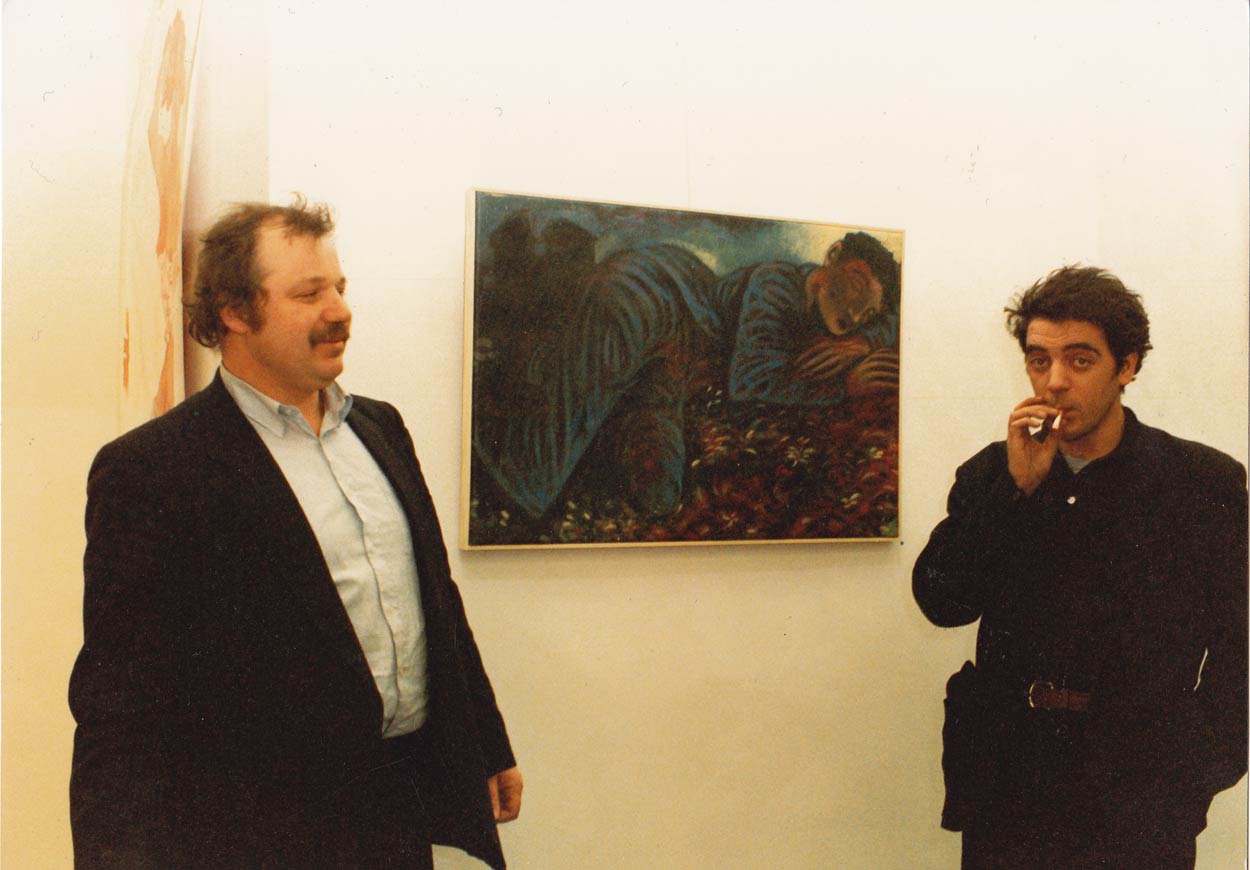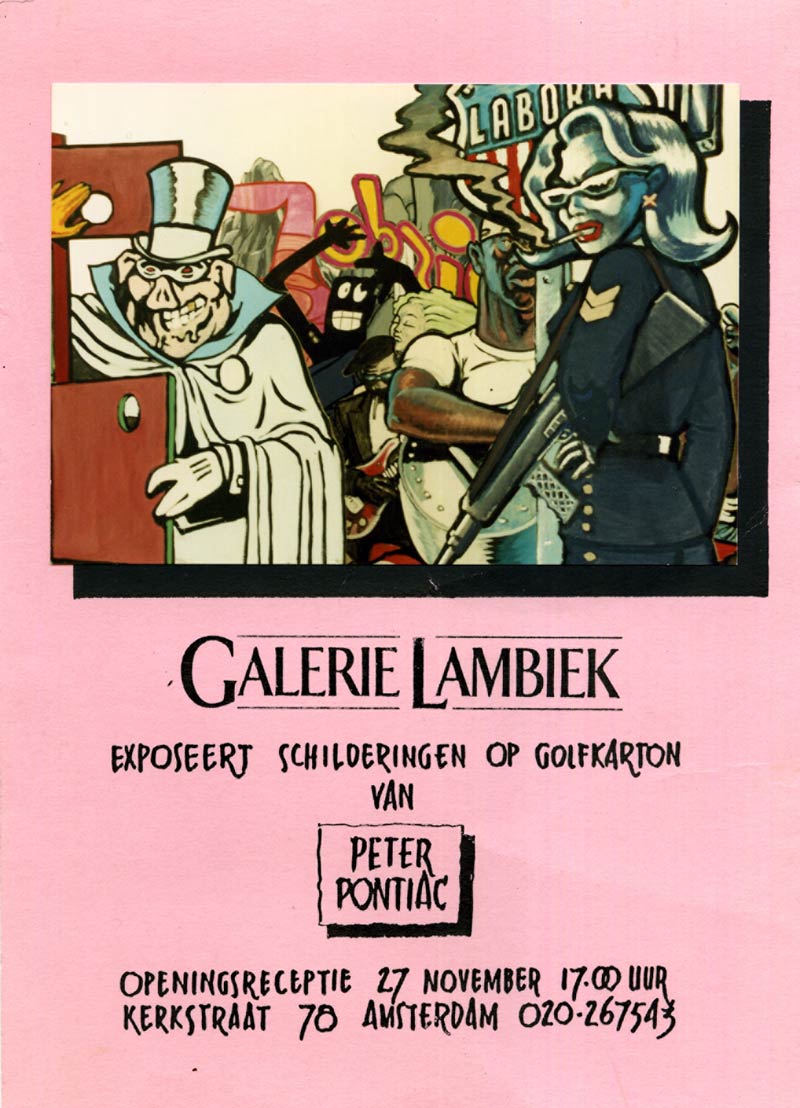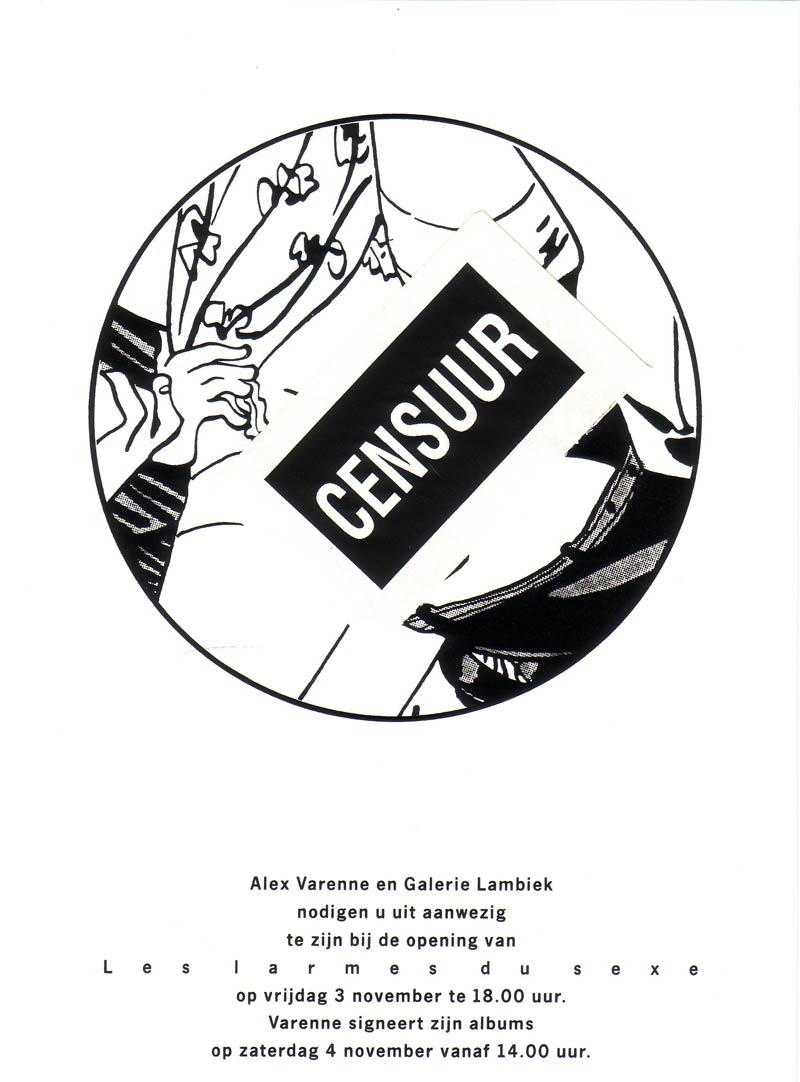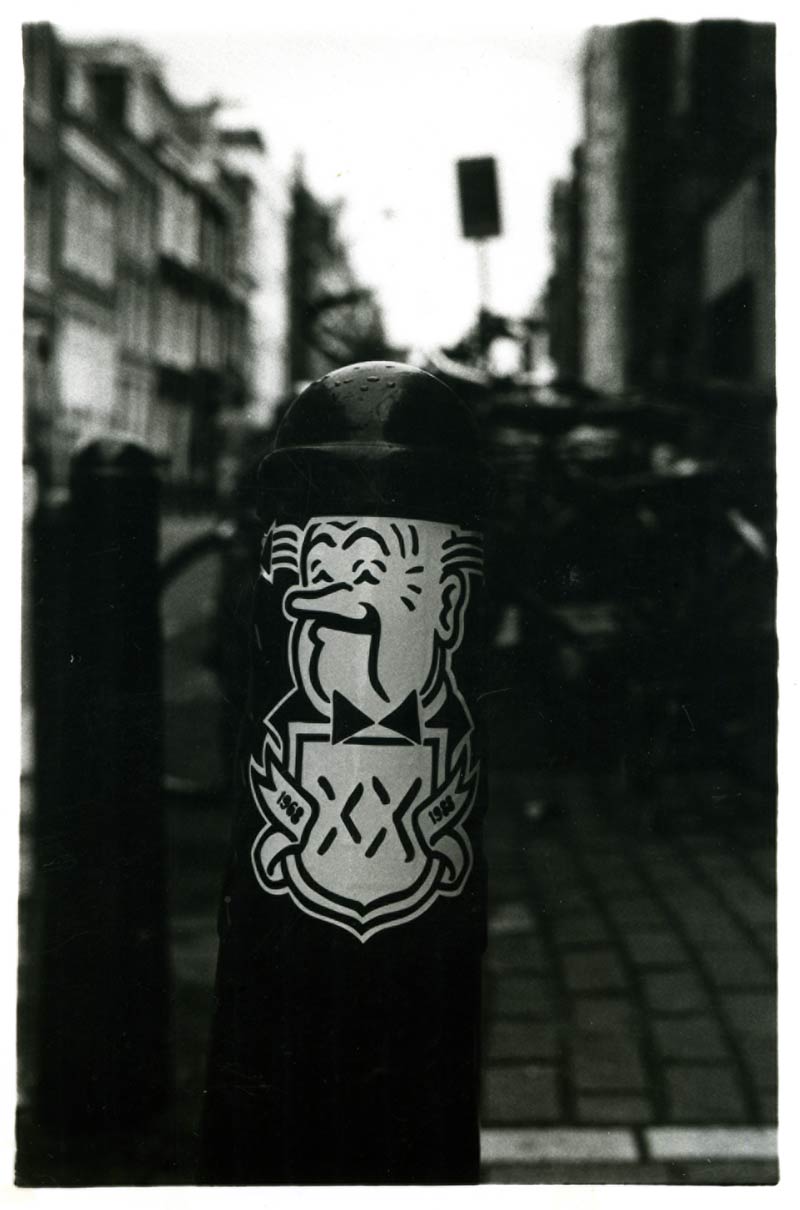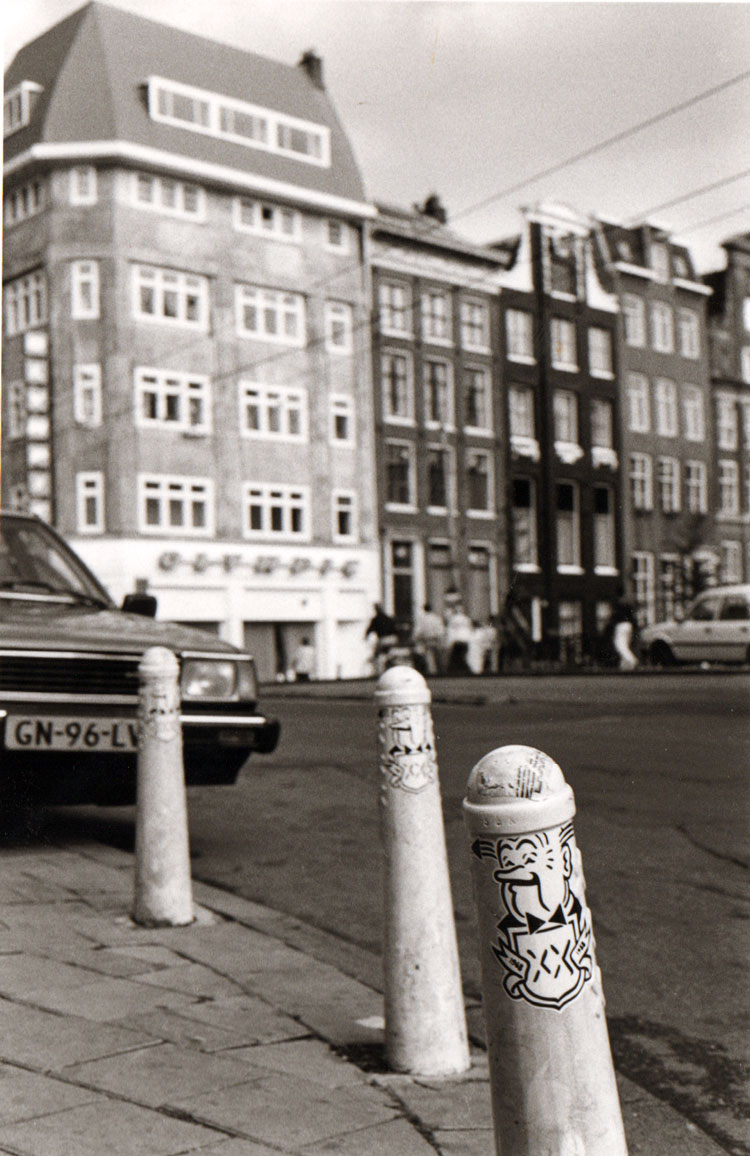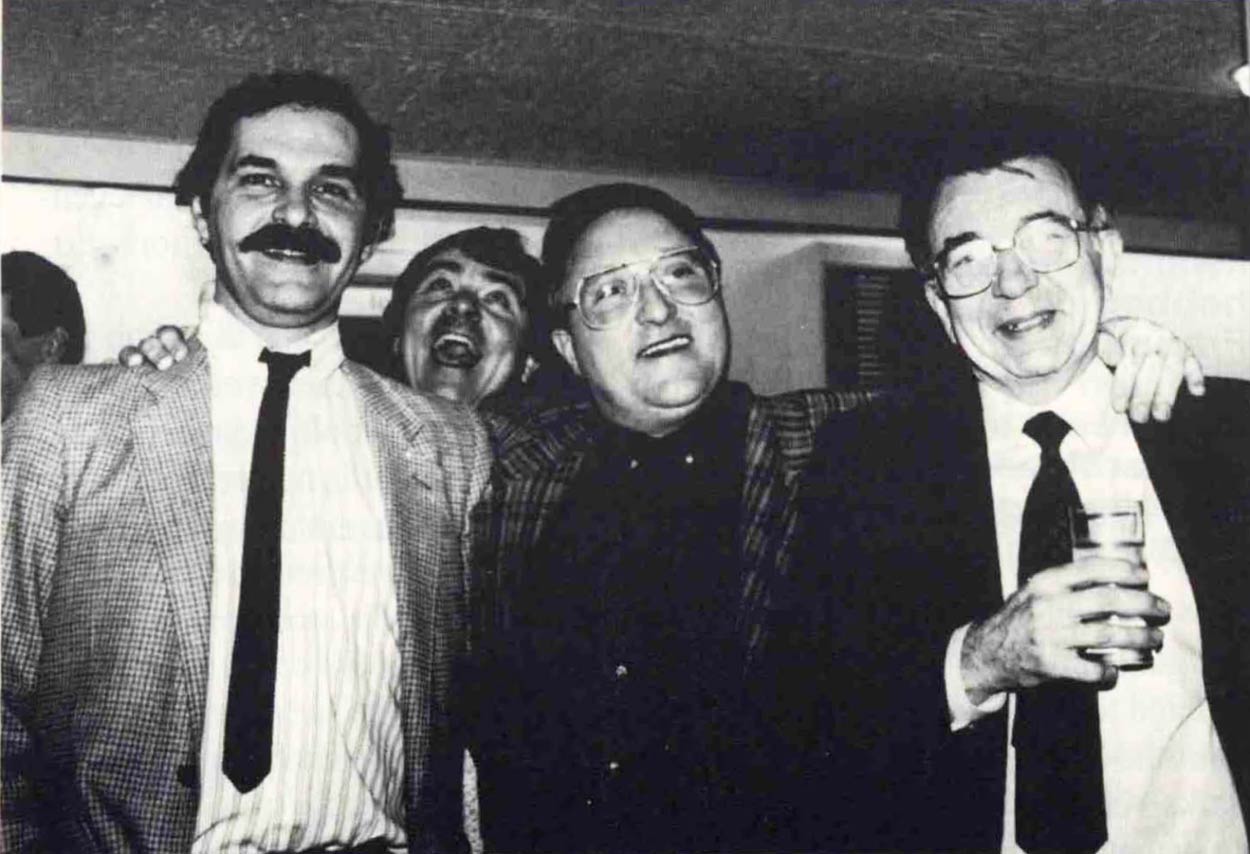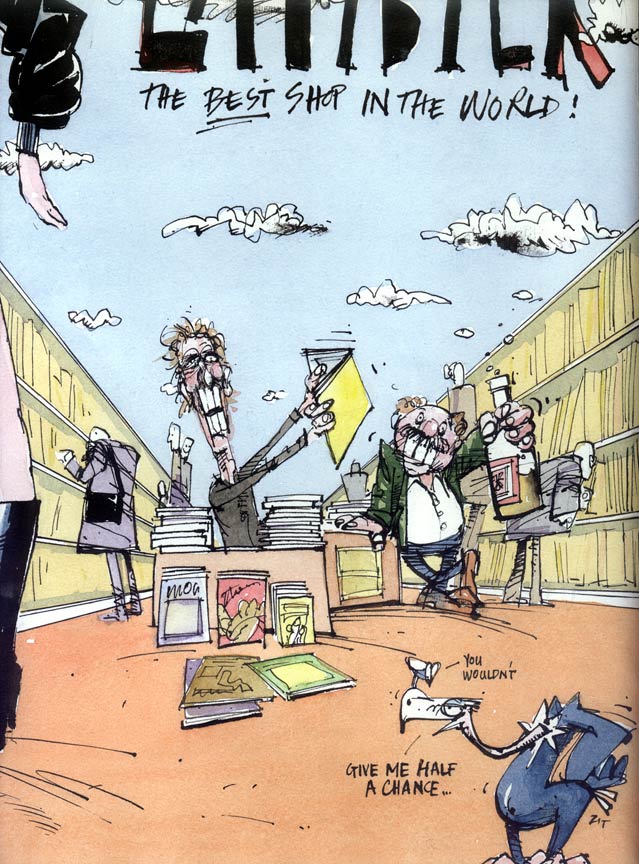Comics History
Lambiek at Kerkstraat 78 (1986-1989)
Interior drawing of the Kerkstraat 78 store by Peter Pontiac.
Lambiek's rising reputation in the 1980s
During the 1980s, 1990s and early 2000s, Lambiek managed to get more media attention than ever before. The larger store provided more opportunities to fulfill Kees' mission: treat comics as a serious art form. This was why Lambiek's comic albums and graphic novels were arranged on the shelves not by genre or title, but in alphabetical order based on the author's last name, just like in general bookstores. This often puzzled customers, but Kees felt the authors should be the focal point.
Lambiek became a meeting place for various internationally famous comic artists, who passed by to sign their work and, starting in 1986, exhibit there too. Official visits to Lambiek were turned into huge media events. Kees wrote a personal opening speech for all of them. Prestigious critics and journalists were invited to add attend Lambiek's gallery openings. Certain artists, who weren't household names among the general public, gained valuable exposure by exhibiting their work in Lambiek. Foreign artists became better known among Dutch readers. Ever since the 1970s, Lambiek had given young amateurs the chance put their own comics on sale, or exhibit some of their drawings. Several of them later became professionals, including Joost Swarte, Gerrit de Jager, Hanco Kolk, Peter de Wit, Windig & De Jong and Jean-Marc van Tol. Many of these artists returned the favour by making promotional artwork for the store or by putting Kees cameos in their own comics. This provided Lambiek with a loyal entourage.
Utrechts Nieuwsblad writing about Kees' plans for a gallery (8 March 1986).
Kees' worldwide popularity rose as well. Increasingly, people invited him to write essays, to give lectures and interviews, to be a jury member for a panel, or to co-organize events. From all over the world, people wrote him letters. Kees kept correspondence with other cartoonists too. Some he tried to invite to the store, others invited themselves. Kees even saved the stamps from every letter he received, to sell later to philatelists.
In his spare time, Kees documented himself about comics and collected any magazine article about them. Many were research for his own projects. The eager storeowner also published special editions of certain artists' work, regardless whether there was an actual market for it. Most of his investments were paid for with money from his own pocket. Whenever foreign artists visited his store, he personally took care of their hotel costs and travel expenses. After Kees bought the Kerkstraat 78 building, he let his foreign visitors stay in the studio apartment on the first floor. People sometimes regarded Kees as an eccentric who invested time and money in the questionable pursuit elevating cartoonists' status in society. Whenever Kees had the feeling people belittled him, his store or the artists he tried to promote, he wasn't afraid to speak up. He could be quite frank in his opinions, but always layered it with witty sarcasm. To Kees, all that mattered was doing what he loved best - bringing comic artists together in his store. Above all, Kees was a resourceful businessman. Lambiek was the place to go not only for antiquarian comics, but also for more prestigious items like silkscreens, posters and original artwork. Setbacks were used as full scale PR-stunts, as the Punch and Judy show with the doll from the previous chapter illustrates.
Joost Swarte's drawing for the official opening of Gallery Lambiek on 18 October 1986.
Gallery Lambiek
Ever since 1976, Kees had tried to host large-scale exhibitions in Lambiek, but there was never enough room to display framed drawings on the wall, or invite big crowds. Even after moving to a new and bigger building in 1980, most of the store was filled with stacks and stacks of comics, as well as a reading table. Kees noticed that most collectors already owned all the antiquarian stuff, so some books would probably never be sold. The cluttered mess was also a paradise for shoplifters. Kees wanted to redesign part of his store into an actual art gallery. In order to do so, sacrificies had to be made. Starting 1 March 1986 on Lambiek employees tried to sell as much stuff as possible. To avoid Kees trying to protect his proud possessions, he was sent off on a holiday. After his return, there was definitely enough sold to go ahead with the redesign. Goof Mensink and Job Goedhart were put in charge of "re-store-ations", so to speak. Walls were repainted to give the upcoming gallery a classy look. Lambiek finally started to look like a mini-museum, the way Kees wanted it.
Raw exposition... almost ready to go!
Kees envisioned a classy, prestigious atmosphere. All exhibitions revolved around artists whose work was visually interesting or captivating reading. With each event, special silkscreen posters from the exhibition anouncements were made. Average museumgoers, art lovers, critics and beau monde were encouraged to come and have a look. Fellow cartoonists and graphic artists naturally were interested too, and ended up bringing along more celebrity comic artists to the store. Performances by orators, comedians and musicians were organized. Drinks and snacks were provided, and Kees' flamboyant opening speeches topped everything off. While Kees wanted the events to be taken seriously, he still enjoyed cracking jokes inbetween and afterparties were encouraged. After closing time, the festivities often continued at Café Terzijde, across the street.
At the time, no other comics store in the world organized events like these. The exhibitions provided Lambiek with constant publicity and added prestige, and soon the store's favorable reputation spread far beyond the Dutch-language comics circles. Artists who couldn't afford a hotel could always sleep over upstairs in the Lambiek cartoonist loft, an apartment over the store. Many doodled some drawings and signatures behind in the guestbook or on the studio wall. Among them people like Al+Flag, Eric Braün, Hélène Brosseau, Sophie Crumb, Bob Fingerman, Ellen Forney, Janet and Michael T. Gilbert, Roberta Gregory, Lian Ong, Pete Poplaski, Eric Reynolds, David Sandlin, Dan Schiff, Seth, Jeff Smith, Barbara Stok, James Sturm, Willem and Jim Woodring.
Invitation for the Raw exposition. Artwork by Charles Burns.
Exhibitions and book signings (1986-1989)
The first big-scale exhibition in Lambiek took place on 18 October 1986 and revolved around Art Spiegelman and Françoise Mouly's refined high-brow comics magazine, Raw. Raw was a revelation at the time, because it gave experimental comic artists the chance to have their works be presented in a high quality format, with printing that paid attention to fine details. Raw aimed to prove that comics could be art (and vice versa). Kees was of the same mind about the comic medium, so Raw was the perfect choice for Lambiek's first gallery exhibiton. Coincidentally, the first issue of Raw was published in the summer of 1980, around the same time that our store moved to a location with enough space for us to create an art gallery for comics exhibitions. The Raw exhibition was more than symbolic - it was a cross-Continental celebration of comics as fine art. Although Spiegelman visited Lambiek in 1979, even contributing an exclusive drawing to an issue of the Bulletin, he and Mouly weren't present at the expo. The actual instigator of the exhibition was Dutch artist who published in Raw's pages: Joost Swarte. Works of Swarte, Spiegelman, Mark Beyer, Charles Burns, Kim Deitch, Pascal Doury, Scott Gillis, Kaz, Jerry Moriarty, Mark Newgarden, Gary Panter, Bruno Richard and Ever Meulen were hung on the walls. Many of these comic artists had been featured in museums before, but this was the first time that Raw contributors had been exhibited as a collective.
Between 6 January until halfway March 1987, the innovative Spanish artist Ceesepe ('Dibujos', 'Barcelona By Night', 'Slober') was the subject of an exhibition. After his first visit to the Netherlands three years earlier, this attempt to promote his work was more successful. His expo 'Tristesse de Luxe' ran for three months. Between 27 November 1987 and 31 January 1988, Lambiek's home cartoonist Peter Pontiac was the center of attention. Pontiac already exhibited work a decade earlier, but this was the first time he could be seen in our brand-new gallery. Especially for this show, the Dutch underground legend created original cut-out artwork from large pieces of cardboard. Pontiac returned for signing sessions in 1990 and 2011.
Invitations for the Peter Pontiac and Alex Varenne expositions. The uncensored Varenne image is available by request.
From 26 February until the last week of April 1988 the iconoclastic cartoonist Tanino Liberatore, of 'RanXerox' fame, exhibited his savage drawings in our gallery. The cult cartoonist was succeeded by the refined artwork of Jacques de Loustal, which marvelled audiences from 3 February until halfway March 1988. It was the first time that Loustal's art was exhibited in the Netherlands. Philippe Bertrand, best known for 'Linda Aime L'Art' and his equally magnificent erotic work, could be seen between 31 March and 15 May 1989. In between that period, Dutch cartoonists Hein de Kort and Eric Schreurs held a book signing on 15 April. The creators of filthy and provocative series like De Kort's 'Pardon Lul' and Schreurs' 'Joop Klepzeiker' and their collective comic strip 'Dick van Bill' proved that our store hadn't forgotten fans of straightforward entertainment. The futuristic cityscapes of 'Cités Obscures' creator François Schuiten were simply made for a gallery and therefore his detailed illustrations could be admired between 8 September and October 1989. Alex Varenne closed the decade with 'Les Larmes du Sexe', an exhibition which ran from 3 November until December 1989. The artist behind erotic series like 'Erma Jaguar' lived up to his reputation. The illustration on the official invitation card showed an explicit close-up of a penis penetrating a vagina. Kees took the precaution of adding an optional censor badge to it, which could be removed if desired.
Events in 1988-1989
Removal was a major theme at the tail end of the 1980s and we're not just referring to the Berlin Wall. On 25 May 1988, our store was once again victim of a burglary. Four screenprints by Joost Swarte, a couple of illustrations by Marten Toonder and a few statuettes were stolen. Throughout the year we fought a legal battle to get our "Lambik" doll back, but also took a stance in the "Amsterdammertjes" affair. The Amsterdam city council felt the need to remove many of their iconic red-brown traffic bollards. These iron (later steel) objects had always been a typical sight in the city and were therefore nicknamed "Amsterdammertjes". To protest against their removal, Lambiek had several stickers made with Lambik's face on it, simultaneously advertising the 20th anniversary of our store on 8 November of that year. When stuck to the pole it made the top half look like Lambik's bowler hat. Additionally, Lambik's sideburns doubled as arrows, theoretically pointing potential customers in the direction of the store. The design was courtesy of Herwolt van Doornen.
Joop Distel, the brand new Knight in the Order of the "Golden Vacuum Cleaner", surrounded by Mr. Cox, another Dupuis representative, and comic artists François Walthéry and Berck.
Luckily, there were more pleasant events that period too. On 5 November 1988, Kousemaker held a survey under his fellow comics storeowners to find out who was the best comics sales representative? Joop Distel, representative of Dupuis in the Netherlands, came out best. So Kousemaker awarded him a humoristic knighthood: "Ridder in de Orde van de Gouden Stofzuiger" ("Knight in the Order of the Golden Vacuum Cleaner"). He gave the prize to Distel during the annual Stripschap anniversary, held in hotel Bel Air in The Hague. Among the people present at this ceremony were comic artists Berck ('Sammy') and François Walthéry ('Natacha').
Another cartoonist, the South African Derek Bauer, drew a graphic homage to our store in 1989. He caricatured the inseparable Kees and Klaas Knol. Yet the most beautiful piece of promotional art ever created for our store was drawn by Peter Pontiac that year. The first illustration depicts a street plan of Amsterdam, helping out tourists on how to find our store. The other offered a look inside Lambiek, picturing Kees and Klaas at their counter while various famous comics characters pick out comics to buy. The drawings were so magnificent that there were made into official brochures and posters. To continue our story about Lambiek's eventful history we cannot provide an illustrated guide by Pontiac though, you just have to follow the link below...
Detail of Derek Bauer hommage to Lambiek, featuring Klaas and Kees.


